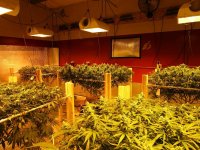Cerathule
Well-known member
I'm sorry but the phytochrome photoreceptor family has nothing to do with the photosystems. The 2 photosystems are each comprised of around a hundred chlorophylls + some accessory pigments in order to harvest light energy, dissociate water to gather electrons in PSII, and use these at the end of PSI to make energy-rich primary compounds.Where are you reading this?
I also apologize for being sloppy, its of course Pr and Pfr, not Pf and Pfr.
Pr and Pfr is two states of the phytochrome receptor protein. When it processes photosynthesis it has to go thru both forms to complete the process and the creates sugar and O2 out of CO2 and H2O. Each form has its function in this process, it has to go thru both states to complete the chemical process. Having access to both red and far red means that this process get faster and more efficient (emmerson effect). But the phytochrome also does more than this, it also measures night and day (nightfall means Far red > red light) and if the plant is in the shade (again Far red > red). So its a bit unexact to say that the Pr completes process that limit stretch; this whole stretch thing is kind of a byproduct to how the plant does red light photosynthesis: Pr and Pfrs main function is this and not photosensing.
Here are some primers on this if you like.
https://bio.libretexts.org/Bookshelves/Introductory_and_General_Biology/Book:_General_Biology_(Boundless)/30:_Plant_Form_and_Physiology/30.18:_Plant_Sensory_Systems_and_Responses_-_The_Phytochrome_System_and_Red_Light_Response#:~:text=Exposure to red light converts,the inactive form (Pr).
photosystems I and II
photosystems I and II - pigment systems I and II, PSI andwww.botanydictionary.org
The phytochromes sense, and weigh, the light qualities at the red end of the spectrum and the plant react to this in a lot of ways. Photosynthesis is also largely, and multifoldly, affected by this, but it's not that the 2 phytochrome absorbtion spectras are the same, or deriven from the same, as the 2 photosystem ones. But these 2 do indeed share almost a similar max quantum-effect peak - at around 725-735 for PSI & Pfr and 660-680 for Pr and PSII.



